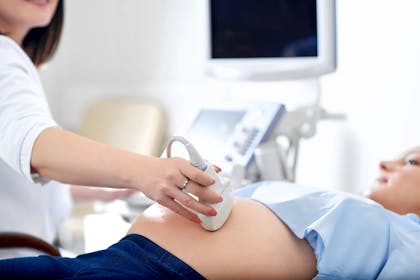Your anomaly scan – also referred to as the 20-week scan – checks for physical abnormalities in your baby such as heart defects, cleft lip and spina bifida. It's also the scan that can reveal if you're having a boy or a girl. Here's what to expect.
This page contains affiliate links, which means we may earn a small amount of money if a reader clicks through and makes a purchase. All our articles and reviews are written independently by the Netmums editorial team.
If you've been dying to find out whether you're having a boy or a girl since the second you found out you were pregnant, the wait is finally over.
But, although it's possible to identify the sex of your baby at an anomaly scan, this mid-pregnancy scan is much more than a gender prediction test.
The anomaly scan (also known as the 20-week scan) is primarily designed to check for any abnormalities in your baby's growth and development.
FREE NEWBORN NAPPIES
The person who performs the test (sonographer) will make sure organs such as the baby's heart, kidneys, brain and bones are developing properly. The scan can also help to identify conditions such as spina bifida, heart defects and cleft lip, among others.
Hopefully, your anomaly scan will show a healthy, growing baby boy or girl. However, if it does find anything unusual, you'll have support and staff ready to help with the next steps.
In the meantime, here's more about what this particular ultrasound scan is looking for and what to expect from the appointment.
When will I have my anomaly scan?
The NHS recommends that your anomaly scan happens when you're between 18 and 21 weeks pregnant.
Although it's referred to as the 20-week scan, don't worry if it's a little later or earlier than this.
If you're coming up to 18 weeks and don't have an appointment booked yet, you can contact your midwife to request one if you want.
Where will I have my anomaly scan?
It's likely to happen in the same place that you had your dating scan , usually at the ultrasound unit of your local hospital.
Will I have to pay for the scan?
The scan itself is free, but you may have to pay if you want them to print out a photo for you to take home. You'll probably also need change for the hospital car park.
What happens at my anomaly scan?
Your anomaly scan will be similar to your dating scan but it may take a little longer – up to around 30 minutes. You may not need a full bladder this time, though some women do; if you're unsure, check with your midwife.
Tell the sonographer at the start of the appointment whether you want to find out your baby's sex or not. If you want to find out, most sonographers will check for you. If you don't want to find out, be sure to mention it before your sonographer blurts it out!
Then you'll lie down and the sonographer will apply some cold gel to your bump before gliding a probe over it to start seeing pictures on the screen.
Don't worry if your sonographer doesn't talk much at first. They need to concentrate in order to check that the baby's organs look OK, and to get all the measurements they need.
If your sonographer can't get a good view of the baby, they may ask you to empty your bladder, roll around or walk around the room so don't be alarmed. They may even seek a second opinion or have a trainee or student in with them (if you say you're OK with at the start of the appointment).
Once your sonographer has finished the necessary checks, they'll show you the screen and point to specific parts of your baby.
Although an anomaly scan is another lovely chance to see images of your baby, it can also alert you to any problems with the pregnancy.
That's why it's a good idea to take your partner or family members along with you, for added support. Children won't usually be allowed in the room for the appointment though so it's best to leave them with someone else while you have your scan.
During the coronavirus pandemic, some hospitals are asking women to come in alone for scans, if there isn't room to safely accommodate anyone else. But it's still a good idea to have someone waiting for you outside, so you can share the emotions of the day.
If there are any problems or concerns the sonographer will explain these at the appointment. You'll be able to see a midwife afterwards should you need to discuss anything or book in for further scans or tests.
Will I get a picture of my baby?
Yes, most hospitals will offer you a printout from the scan, but you may need to pay for it. This is usually around £5, and you may have to pay in cash.
We love this adorable frame that's designed especially to hold scan photos. See more details here at Amazon.
You can also have your baby's scan photo made into a keyring. See more details here at Etsy.
What does an anomaly scan detect?
During the scan, the sonographer will measure parts of your baby's body, to see how well they are growing. The sonographer will measure your baby's:
- abdominal circumference (AC)
- thigh bone (femur) (FL)
- head circumference (HC)
The measurements should match up to what's expected for your baby, depending on when the due date was predicted in the dating scan. They'll be recorded in your maternity notes .
The sonographer will also pay careful attention to your baby's:
- heart
- brain
- bones
- spinal cord
- face
- kidneys
- abdomen
This way, they can look out for heart defects, cleft lip and other physical abnormalities.
The NHS also states that there are 11 conditions that the anomaly scan is looking for. These are:
- anencephaly – where the baby is born without parts of the brain and skull
- open spina bifida – a condition affecting the forming of the baby's backbone
- cleft lip – a gap in the upper lip or roof of the mouth
- diaphragmatic hernia – an opening in the diaphragm
- gastrochisis – where the baby's organs grow outside the body
- exomphalos – abdominal wall defect
- serious cardiac abnormalities – heart problems
- bilateral renal agenesis – absence of kidneys
- lethal skeletal dysplasia – a bone growth disorder
- Edwards' syndrome – a rare but serious chromosome disorder
- Patau's syndrome – a rare but serious genetic disorder.
However, rest assured that these conditions are rare and most anomaly scans will find nothing but a healthy, developing baby boy or girl!
Can I find out my baby's sex at the anomaly scan?
In many cases, yes. Your baby is now developed enough for it to be possible for a sonographer to tell if you're having a boy or a girl.
By 18 weeks pregnant, ultrasound scans are usually more than 99% accurate at determining the sex of a baby.
However, there's no guarantee that you can find out. If your baby's moving a lot, or in an awkward position, the sonographer may not be able to get a good enough look.
Some hospitals also have a policy to never reveal the sex. If you're keen to find out, it might be worth ringing ahead and asking what the policy is at your local hospital.
Can an anomaly scan harm my baby?
No. Ultrasound scans are considered to be perfectly safe. Pregnant women have been having them for many years now, and no safety concerns have been reported.
Nonetheless, many experts recommend that you stick to just the scans that are recommended by the NHS, to be on the safe side.
Find out more about how scans work and their safety record .
Do I have to have an anomaly scan?
No, it's entirely your choice as to whether you have the anomaly scan or any scan during your pregnancy.
For most mums-to-be it offers huge peace of mind when they find out everything's OK, which is what happens in the majority of anomaly scans.
In the rare case that the scan finds a problem, you'll have support to help you deal with this and for some, finding out sooner rather than later is preferable.
If you don't have the scan, you'll still be entitled to future antenatal appointments.
What happens if there's a problem?
If the sonographer isn't happy with something, they may recommend a repeat scan. This could simply be due to the baby not lying in the correct position to allow for a complete scan.
If your sonographer does find a particular problem, they'll tell you straight away and talk you through the next step.
This may be to book in with your midwife, refer you to a specialist or make an appointment for further tests. Before anything further happens, you'll be given information to read so that you can make the best choice for you and your baby.
If you've had bad news and you're not sure where to turn, the charity Antenatal Results and Choices has a helpline for advice and support. Call 0207 713 7486 between 8-10pm on Tuesday or Thursday, or email info@arc-uk.org to arrange a call back.
You can find out more about the ultrasound scans on offer during your pregnancy here .
In the meantime, you'll always find support and reassurance from fellow mums-to-be in our chat forum .






